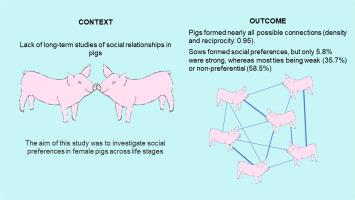Long-term social preferences in a group of sub-adult female pigs
IF 1.9
3区 农林科学
Q2 AGRICULTURE, DAIRY & ANIMAL SCIENCE
引用次数: 0
Abstract
Social relationships in farm animals, including pigs, have become a focus of research, yet long-term studies are scarce. Pigs, being highly social animals, offer an excellent model to explore social preferences over time. This study aimed to investigate social preferences in female pigs across life stages by observing a group of ten gilts over one year, with each season serving as an assessment point. Social interactions (allogrooming, snout-body, and snout-head contact) were recorded through live and video observations, totaling 396 h per animal. Social Network Analysis (SNA) assessed group cohesion using measures of density, reciprocity, and degree centralization. Monte Carlo simulations, half-weight association index (HWI) and the Quadratic Assignment Procedure (QAP) were used to evaluate social preferences and their recurrence across seasons. Results showed high density (0.95) and reciprocity, with weak centralization (in-degree 0.19, out-degree 0.27), indicating uniform distribution of social interactions. On average across the four seasons, 5.8 % of connections were strong, 35.7 % weak, and 58.5 % non-preferential. Social preferences correlated modestly between autumn and winter, but not with summer and spring. This study confirms previous findings that only a small proportion of pigs form non-random associations within a group. Social preferences lasted for a maximum of two seasons, likely influenced by pregnancy and transitions from gilt to adult sow, which resulted in temporary withdrawal from the group.

一群亚成年母猪的长期社会偏好
包括猪在内的农场动物的社会关系已成为研究的焦点,但长期研究很少。猪是高度社会化的动物,它提供了一个很好的模型来探索随着时间推移的社会偏好。本研究旨在通过对一组10只母猪进行为期一年的观察,以每个季节为评估点,调查母猪在整个生命阶段的社会偏好。通过现场和视频观察记录了每只动物的社会互动(异体梳理、鼻子-身体和鼻子-头部接触),总计396小时。社会网络分析(SNA)使用密度、互惠和集中化程度来评估群体凝聚力。采用蒙特卡罗模拟、半权重关联指数(HWI)和二次分配程序(QAP)来评估社会偏好及其在季节间的复发性。结果表明,社会互动具有较高的密度(0.95)和互惠性,集中程度较弱(入度0.19,出度0.27),表明社会互动分布均匀。在四个季节中,平均5.8%的连接是强连接,35.7%是弱连接,58.5%是非优惠连接。社会偏好在秋季和冬季之间适度相关,但与夏季和春季无关。这项研究证实了先前的发现,即只有一小部分猪在一个群体中形成非随机关联。社会偏好最多持续了两个季节,可能受到怀孕和从后备母猪到成年母猪的转变的影响,这导致暂时退出群体。
本文章由计算机程序翻译,如有差异,请以英文原文为准。
求助全文
约1分钟内获得全文
求助全文
来源期刊

Livestock Science
农林科学-奶制品与动物科学
CiteScore
4.30
自引率
5.60%
发文量
237
审稿时长
3 months
期刊介绍:
Livestock Science promotes the sound development of the livestock sector by publishing original, peer-reviewed research and review articles covering all aspects of this broad field. The journal welcomes submissions on the avant-garde areas of animal genetics, breeding, growth, reproduction, nutrition, physiology, and behaviour in addition to genetic resources, welfare, ethics, health, management and production systems. The high-quality content of this journal reflects the truly international nature of this broad area of research.
 求助内容:
求助内容: 应助结果提醒方式:
应助结果提醒方式:


